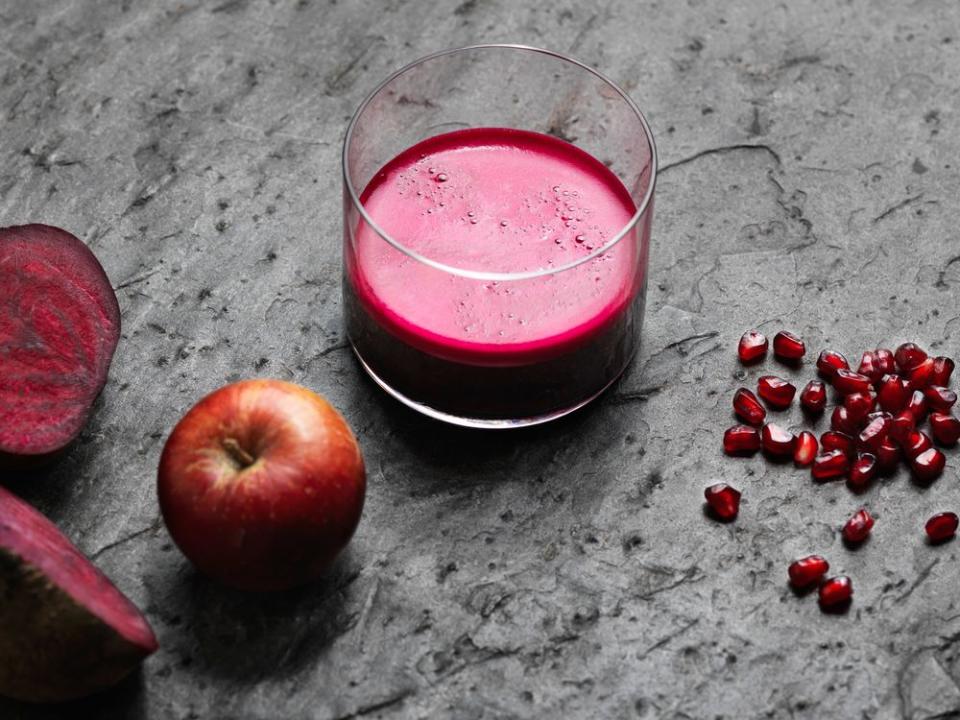How to Pair Dinner with Juice, According to a Sommelier
Inside Britannia, the historic hotel in Trondheim, Norway, the menu at the eponymous bar showcases cocktails inspired by the city’s past, dreamed up by head bartender Øyvind Lindgjerdet and fact-checked by two historians. At Vinbaren, Britannia’s wine bar, a cellar holds over 10,000 bottles—some of which cost upward of $20k—that are paired with the chef’s tasting menus at the swank Speilsalen. Guests also have the option of forgoing wine in favor of a juice pairing.
In the past few years, alcohol sales have declined in the U.S. as consumption has decreased, giving a boost to alternatives, like the distilled non-alcoholic spirit Seedlip, and prompting brands to introduce booze-free offerings, like Coca-Cola’s Bar None—a line of cocktail-inspired drinks. As consumers and brands have embraced the trend, so have bars and restaurants, from more casual spots with dedicated mocktail menus to alcohol-free pairing options in fine-dining restaurants.

René Redzepi was a juice pairing pioneer at Noma—using fermented fruits and plants, herbal infusions, and other ingredients as meticulously-selected as the rest of his menu—and at Atera in New York City, guests can opt for the “temperance pairing” instead of wine that includes more cocktail-inspired drinks, like the cote de beet, with beet juice, toasted oak, black currant, and thyme oil. At Spice Finch in Philadelphia, a non-alcoholic cocktail menu includes the N/A groni, with san bitter and chinotto. When the same consideration is put into a non-drinker’s experience, it normalizes something that should be normal, and signals to abstaining guests their experience matters.
According to Henrik Dahl Jahnsen, Speilsalen’s head sommelier and four-time Norwegian wine sommelier champion, offering guests juice was a natural choice.
“We sincerely believe there has to be an alternative to wine for those who do not want to drink alcohol, whatever the reasons,” he says. Too often, a restaurant’s alcohol-free options are limited to club soda or bland non-alcoholic beer. “A well-conceived juice, made of the best ingredients and cold-pressed, offers a much more gastronomic experience.”
RELATED: 6 Non-Alcoholic Drinks That Pair Beautifully with Cheese
Helmed by Bocuse d'Or Silver medal winner chef Christopher Davidsen, Speilsalen (Norwegian for “Mirror Hall”) has six- or ten-course tasting menus, which Jahnsen can pair with wines selected to complement the menu highlighting Norwegian produce and ingredients, or juices that do the same. A vegetarian dish, for example, made with fermented Brussels sprouts, black garlic and Jerusalem artichokes, is served with a glass of vibrant and palate-cleansing fresh-pressed apple, ginger, and lemon juice. “Freshness from the apples blends together with bright acidity from the lemon and a touch of heat from the ginger,” says the sommelier.
Below, find Jahnsen’s top tips for pairing a meal with juice, whether you don’t drink alcohol, or just want to experience a meal in a whole new way.
Tip 1: Let wine pairing be your guide
With so much fruit and vegetable variety, it’s tough to make hard-and-fast rules that apply to every dish, so Jahnsen first considers which wines would pair well.
“Is there enough acidity and/or freshness?” he says. “If the dish is on the heavier side, the juice has to be fresh enough to cleanse your palate and tasty enough not to fall short of the flavors on the plate.” Similarly to wine pairing, the juice options are also based on flavor profiles of the dish. “For example, we emphasize a dish’s spiciness, or offer a contrasting and commanding acidity.”
Tip 2: For the main course, go with earthy flavors
According to Jahnsen, earthy flavors tend to work well with a main course, where the substance of the dish and juice should go hand in hand.
“One of my favourite juices is apple based, but flavoured with a generous amount of carrot and turmeric—the turmeric gives you that dryness that could resemble tannins in an oaked or skin-contact white wine," he says.
Similarly, they often use beet juice to go along with meat dishes. “The color works on an optical and aesthetic level and, again, the earthiness offers an interesting and tannin-like mouthfeel," he says "As the beetroot can easily be a bit overpowering, this juice also features quite a bit of apples and some lemon and ginger for extra vibrance.”
Tip 3: Embrace dessert juice
Don’t forget dessert! At Speilsalen, Jahnsen pairs the course—featuring elderberries, white chocolate, hibiscus, and vanilla—with a juice blend of red oranges, dates, and star anise. A little sweet, a little complex, dessert juice is a satisfying finale to the meal.

